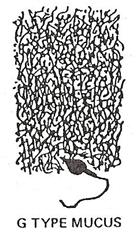G Mucus:
G mucus is a high-viscosity elastic stopper which acts as a natural barrier to sperm. (Fig. 11-11). G mucus is present in the cervical canal in all phases of the menstrual cycle except during the fertile phase and menstruation. G mucus secretion is stimulated by progesterone and is produced in the G crypts at the lower end of the cervix in the infertile phase of the cycle. Usually no sensation is associated with G mucus, and the days are dry during the infertile phase.1,2

Fig. 11-11; Structure of G Mucus: A diagram of the structure of G mucus which acts as a complete barrier to the movement of sperm in the cervical canal. >>
In the beginning of a normal menstrual cycle shortly after menstruation, the G mucus fills up the cervical canal, and this also occurs after ovulation, acting as a barrier between the vagina and body of uterus. G mucus contains immunoglobulins and other anti-microbial agents, protecting the upper genital organs.3
References:
- Odeblad Erik; ‘Cervical mucus and their functions; Journal of the Irish Colleges of Physicians and Surgeons, Jan 1997, Vol 26, No1.;page 28, 29, 30
- Odeblad, E; ‘The discovery of different types of cervical mucus and the Billings Ovulation Method’ page 10, 11, 14, 15, 18 ; Bulletin of the Ovulation Method Research and Reference Centre of Australia, Vol 21, No3; 3-35; Sept 1994. ( google ‘Erik Odeblad, cervical mucus’.)
- Odeblad E, ‘Investigations on the physiological basis for fertility awareness; Bulletin for the Ovulation Method Research and Reference Centre of Australia, vol 29, no 1, p2-11, march 2002, (internet, Billings Ovulation Method. www.woomb.org


